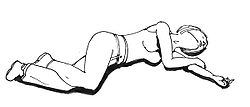m (5 revisions: re-import from WB, including edit history) |
(+trans) |
||
| Line 1: | Line 1: | ||
| + | <noinclude><translate></noinclude> | ||
Shock is a medical condition where the delivery of oxygen and nutrients is insufficient to meet the body's needs. The main carrier of oxygen and nutrients in the body is the blood, so anytime there is a loss of blood, there is a risk of shock. Shock is a life-threatening emergency. | Shock is a medical condition where the delivery of oxygen and nutrients is insufficient to meet the body's needs. The main carrier of oxygen and nutrients in the body is the blood, so anytime there is a loss of blood, there is a risk of shock. Shock is a life-threatening emergency. | ||
[[Image:Recovery position.jpg|thumb|200px|Recovery position]] | [[Image:Recovery position.jpg|thumb|200px|Recovery position]] | ||
| Line 10: | Line 11: | ||
*Prepare for cardiopulmonary resuscitation (CPR). | *Prepare for cardiopulmonary resuscitation (CPR). | ||
*Give as much information as possible when the ambulance arrives. | *Give as much information as possible when the ambulance arrives. | ||
| − | < | + | <noinclude></translate></noinclude> |
| + | {{clear}} | ||
| − | [[Category:Adventist Youth Honors Answer Book|{{ | + | [[Category:Adventist Youth Honors Answer Book|{{#titleparts:{{PAGENAME}}|3|1}}]] |
Revision as of 00:15, 5 November 2014
Shock is a medical condition where the delivery of oxygen and nutrients is insufficient to meet the body's needs. The main carrier of oxygen and nutrients in the body is the blood, so anytime there is a loss of blood, there is a risk of shock. Shock is a life-threatening emergency.
First aid treatment of shock includes:
- Immediate reassurance and comforting the victim if conscious.
- If alone, go for help. If not, send someone to go for help and someone stay with the victim.
- Ensure that the airway is clear and check for breathing. Place the victim in the recovery position if possible.
- Attempt to stop any obvious bleeding.
- Cover the victim with a blanket or jacket, but not too thick or it may cause a dangerous drop in blood pressure.
- Do not give a drink. Moisten lips if requested.
- Prepare for cardiopulmonary resuscitation (CPR).
- Give as much information as possible when the ambulance arrives.

